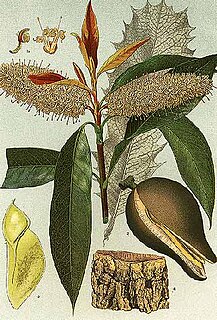
Xylomelum is a genus of six species of flowering plants, often commonly known as woody pears, in the family Proteaceae and are endemic to Australia. Plants in this genus are tall shrubs or small trees with leaves arranged in opposite pairs, relatively small flowers arranged in spike-like groups, and the fruit a woody, more or less pear-shaped follicle.

Lambertia is a genus of flowering plants, belonging to the family Proteaceae. It is endemic to Australia. The genus was named in 1798 by Sir James Edward Smith in honour of English botanist Aylmer Bourke Lambert.
Banksia echinata is a species of shrub that is endemic to Western Australia. It has serrated leaves with nine to twenty-five sharply pointed, triangular teeth on each side, heads of about fifty pale yellow flowers and sparsely hairy follicles.

Lambertia multiflora, commonly known as many-flowered honeysuckle, is a multi-stemmed shrub which is endemic to the south-west of Western Australia. It grows to between 0.5 and 2.5 metres high and flowers from winter to summer.
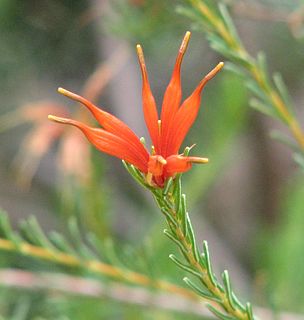
Lambertia ericifolia , commonly known as heath-leaved honeysuckle, is a shrub which is endemic to the south-west of Western Australia. It grow up to 5 metres high and has orange to red flowers which appear from spring to autumn.

Acanthastrea echinata, commonly known as the starry cup coral, is a species of corals in the family Lobophylliidae. It is a wide-ranging species found from the western Indian Ocean, throughout the Pacific Ocean, and eastward to the southeastern Atlantic Ocean. It can inhabit any reef habitat to depths of 50 m. This species, which may become threatened with the global decline of coral reefs, is a popular coral used in aquariums.
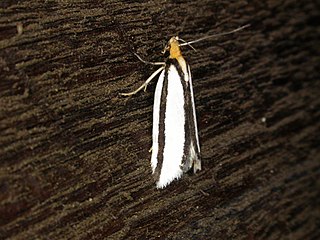
Xylorycta is a genus of moths of the family Xyloryctidae. Xylorycta species are found in Africa and Australia and are strongly associated with the plant family Proteaceae, being found on Hakea, Lambertia, Grevillea, Leptospermum, Macadamia, Oreocallis, Persoonia and Telopea. The larvae of some species bore into stems or branches, or the flower spikes of Banksia, but most live in a silk gallery spun in the foliage.

Lambertia formosa, commonly known as mountain devil, is a shrub of the family Proteaceae, endemic to New South Wales, Australia. First described in 1798 by English botanist James Edward Smith, it is the type species of the small genus Lambertia. It is generally found in heathland or open forest, growing in sandstone-based soils. It grows as a multistemmed shrub to around 2 m (7 ft) with a woody base known as a lignotuber, from which it regrows after bushfire. It has stiff narrow leaves, and the pink to red flowerheads, made up of seven individual tubular flowers, generally appear in spring and summer. It gains its common name from the horned woody follicles, which were used to make small devil-figures.

Lambertia inermis, Noongar chittick, is a shrub which is endemic to south-west Western Australia. It grows to 6 metres high and flowers from spring to winter. A more complete description is given in Florabase and Australian Flora online.
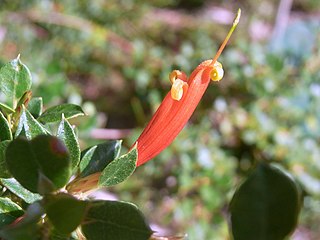
Lambertia uniflora is a shrub in the family Proteaceae. Endemic to the moist south-west corner of Western Australia, it grows to 3 metres in height. Single axillary or terminal flowers appear between October and January in the species' native range. These are orange or red with a yellow or yellow-green limb. This species first appeared in the scientific literature in 1810, authored by the prolific Scottish botanist, Robert Brown.

Acaena echinata, commonly known as sheep's burr, is a species of perennial herb, in the Rosaceae family, native to Australia.

Lambertia orbifolia, commonly known as the roundleaf honeysuckle, is a shrub or small tree that is endemic to the south-west of Western Australia. It has more or less circular leaves and groups of between four and six orange-red flowers.

Lambertia ilicifolia, commonly known as the holly-leaved honeysuckle, is a shrub which is endemic to south-west Western Australia.

Lambertia rariflora, commonly known as green honeysuckle, is a shrub which is endemic to the south-west of Western Australia.
Lambertia fairallii, commonly known as Fairall's honeysuckle, is a shrub which is endemic to the south-west of Western Australia.

Ctenactis echinata is a free-living species of solitary disc coral in the family Fungiidae. It is native to the Indo-Pacific region. This is a common species throughout its wide range and the International Union for Conservation of Nature has rated its conservation status as being of "least concern".
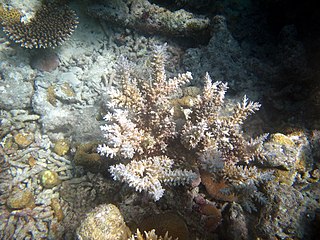
Acropora echinata is a species of acroporid coral that was first described by Dana in 1846. Found in shallow, tropical, sheltered reefs in marine environments, it is found at depths of 8 to 25 m in clear water. The species is listed as vulnerable on the IUCN Red List, and has a decreasing population. It is not common but found over a large area, and is listed under CITES Appendix II.
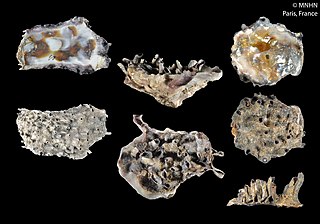
Saccostrea echinata, commonly known as the tropical black-lip rock oyster, blacklip rock oyster, blacklip oyster, and spiny rock oyster, is one of several tropical rock oyster species, occurring in tropical seas across the Indo-Pacific, including coastal waters across northern Australia to Noumea.
















